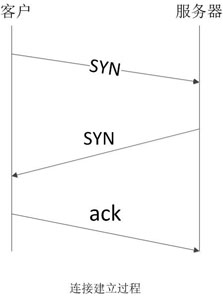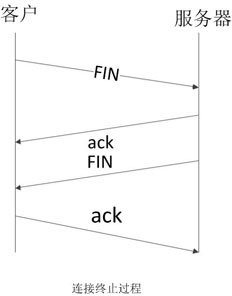python网络编程之TCP通信实例和socketserver框架使用例子
1.TCP是一种面向连接的可靠地协议,在一方发送数据之前,必须在双方之间建立一个连接,建立的过程需要经过三次握手,通信完成后要拆除连接,需要经过四次握手,这是由TCP的半关闭造成的,一方在完成数据发送后要发送一个FIN来终止这个方向的连接,一个TCP连接在收到一个FIN后仍能发送数据,但应用程序很少这么做,下面是TCP连接建立和拆除的过程:


2.python可以实现TCP服务器和客户端的编程,下面是代码:
服务器端:
#!/usr/bin/env python
import socket
host="localhost"
port=10000
s=socket.socket(socket.AF_INET,socket.SOCK_STREAM)
s.bind((host,port))
s.listen(5)
while 1:
sock,addr=s.accept()
print "got connection form ",sock.getpeername()
data=sock.recv(1024)
if not data:
break
else:
print data
客户端:
#!/usr/bin/env python
import socket
host="localhost"
port=10000
s=socket.socket(socket.AF_INET,socket.SOCK_STREAM)
s.connect((host,port))
s.send("hello from client")
s.close()
3.使用socketserver框架编写TCP服务器
Socketserver模块可以简化网络服务器的编写,它包含了四种服务器类,TCPServer使用TCP协议,UDPServer使用UDP协议,还有两个不常使用的,即UnixStreamServer和UnixDatagramServer,这两个类仅仅在unix环境下有用。
使用服务器编程,需要进行一下步骤,先建立一个请求句柄类,这个类继承自BaseRequestHandler类,建立这个类后重写它的handle方法,然后实例化服务器类,把主机名,端口号和句柄类传给它,然后调用server_forever()方法来处理请求。
使用socketserver框架的服务器:
import SocketServer
host=''
port=10000
class Handler(SocketServer.StreamRequestHandler):
def handler(self):
addr=self.request.getpeername()
print "got connection from",addr
self.wfile.write("connected")
server=SocketServer.TCPServer((host,port),Handler)
server.serve_forever()
上面的socketserver服务器只能处理一个请求,如果要处理多个请求,可以用forking或者threading实现,实现多进程或者多线程服务器。下面是使用forking和threading的服务器代码:
使用forking的服务器:
from SocketServer import TCPServer,ForkingMixIn,StreamRequestHandler
class Server(ForkingMixIn,TCPServer):pass
class Handler(StreamRequestHandler):
def handle(self):
addr=self.request.getpeername()
print "got connection from",addr
self.wfile.write('connected')
server=Server((''.10000),Handler)
server.serve_forever()
使用多线程的服务器:
from SocketServer import TCPServer,ThreadingMixIn,StreamRequestHandler
class Server(ThreadingMixIn,TCPServer):pass
class Handler(StreamRequestHandler):
def handle(self):
addr=self.request.getpeername()
print "got connection from",addr
self.wfile.write("connected")
server=Server(('',10000),Handler)
server.serve_forever()

Hot AI Tools

Undresser.AI Undress
AI-powered app for creating realistic nude photos

AI Clothes Remover
Online AI tool for removing clothes from photos.

Undress AI Tool
Undress images for free

Clothoff.io
AI clothes remover

AI Hentai Generator
Generate AI Hentai for free.

Hot Article

Hot Tools

Notepad++7.3.1
Easy-to-use and free code editor

SublimeText3 Chinese version
Chinese version, very easy to use

Zend Studio 13.0.1
Powerful PHP integrated development environment

Dreamweaver CS6
Visual web development tools

SublimeText3 Mac version
God-level code editing software (SublimeText3)

Hot Topics
 Is the conversion speed fast when converting XML to PDF on mobile phone?
Apr 02, 2025 pm 10:09 PM
Is the conversion speed fast when converting XML to PDF on mobile phone?
Apr 02, 2025 pm 10:09 PM
The speed of mobile XML to PDF depends on the following factors: the complexity of XML structure. Mobile hardware configuration conversion method (library, algorithm) code quality optimization methods (select efficient libraries, optimize algorithms, cache data, and utilize multi-threading). Overall, there is no absolute answer and it needs to be optimized according to the specific situation.
 Is there any mobile app that can convert XML into PDF?
Apr 02, 2025 pm 08:54 PM
Is there any mobile app that can convert XML into PDF?
Apr 02, 2025 pm 08:54 PM
An application that converts XML directly to PDF cannot be found because they are two fundamentally different formats. XML is used to store data, while PDF is used to display documents. To complete the transformation, you can use programming languages and libraries such as Python and ReportLab to parse XML data and generate PDF documents.
 How to convert XML files to PDF on your phone?
Apr 02, 2025 pm 10:12 PM
How to convert XML files to PDF on your phone?
Apr 02, 2025 pm 10:12 PM
It is impossible to complete XML to PDF conversion directly on your phone with a single application. It is necessary to use cloud services, which can be achieved through two steps: 1. Convert XML to PDF in the cloud, 2. Access or download the converted PDF file on the mobile phone.
 What is the function of C language sum?
Apr 03, 2025 pm 02:21 PM
What is the function of C language sum?
Apr 03, 2025 pm 02:21 PM
There is no built-in sum function in C language, so it needs to be written by yourself. Sum can be achieved by traversing the array and accumulating elements: Loop version: Sum is calculated using for loop and array length. Pointer version: Use pointers to point to array elements, and efficient summing is achieved through self-increment pointers. Dynamically allocate array version: Dynamically allocate arrays and manage memory yourself, ensuring that allocated memory is freed to prevent memory leaks.
 How to control the size of XML converted to images?
Apr 02, 2025 pm 07:24 PM
How to control the size of XML converted to images?
Apr 02, 2025 pm 07:24 PM
To generate images through XML, you need to use graph libraries (such as Pillow and JFreeChart) as bridges to generate images based on metadata (size, color) in XML. The key to controlling the size of the image is to adjust the values of the <width> and <height> tags in XML. However, in practical applications, the complexity of XML structure, the fineness of graph drawing, the speed of image generation and memory consumption, and the selection of image formats all have an impact on the generated image size. Therefore, it is necessary to have a deep understanding of XML structure, proficient in the graphics library, and consider factors such as optimization algorithms and image format selection.
 How to convert xml into pictures
Apr 03, 2025 am 07:39 AM
How to convert xml into pictures
Apr 03, 2025 am 07:39 AM
XML can be converted to images by using an XSLT converter or image library. XSLT Converter: Use an XSLT processor and stylesheet to convert XML to images. Image Library: Use libraries such as PIL or ImageMagick to create images from XML data, such as drawing shapes and text.
 How to open xml format
Apr 02, 2025 pm 09:00 PM
How to open xml format
Apr 02, 2025 pm 09:00 PM
Use most text editors to open XML files; if you need a more intuitive tree display, you can use an XML editor, such as Oxygen XML Editor or XMLSpy; if you process XML data in a program, you need to use a programming language (such as Python) and XML libraries (such as xml.etree.ElementTree) to parse.
 Recommended XML formatting tool
Apr 02, 2025 pm 09:03 PM
Recommended XML formatting tool
Apr 02, 2025 pm 09:03 PM
XML formatting tools can type code according to rules to improve readability and understanding. When selecting a tool, pay attention to customization capabilities, handling of special circumstances, performance and ease of use. Commonly used tool types include online tools, IDE plug-ins, and command-line tools.






